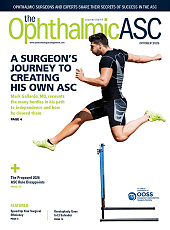The following transcript has been edited for clarity:
Hi, my name is Veeral Sheth, MD; I'm from Chicago, and I had the privilege of presenting the update for the RHONE-X study here at ASRS in California.
The RHONE-X study, just for a little bit of background, looked at the long-term safety and efficacy of faricimab for diabetic macular edema (DME). It’s the largest long-term study to date for DME patients. Basically, what it did is it looked at our core studies, YOSEMITE and RHINE, which were 2-year studies looking at faricimab in DME, and followed those patients out for an additional 2 years. So we were able to see what would happen to those patients that were previously receiving either faricimab every 8 weeks, faricimab treat-and-extend, or aflibercept 2 mg every 8 weeks, and now for the next 2 years followed them out getting faricimab in a treat-and-extend fashion.
We saw some key data points. First, we saw that more than 50% of the patients that received this treat-and-extend faricimab met criteria for potentially a 20-week dosing interval at the end of that 4-year trial. In addition, we saw that BCVA and CST improvements that we saw in YOSEMITE and RHINE were maintained at the end of the 4-year study. We saw that the first time to CST of less than 325 µm was achieved faster and with fewer injections in patients who started with faricimab vs those patients that started with the 2 mg aflibercept.
In addition, we saw that patients that were treated with aflibercept 2 mg in the core YOSEMITE/RHINE study demonstrated further reduction in hard exudates after they switched over to the faricimab treat-and-extend treatment in RHONE-X. This is a new finding that we’re talking about. We know that hard exudates are potentially a marker for severe disease, DME in particular, so it was reassuring to see that these patients that originally received the 2 mg aflibercept that still had hard exudates despite getting 2 years of Q8W aflibercept, once they switched over to faricimab and were extended out, we did see even in those patients a good number of them have resolution of those exudates.
We saw that faricimab was well tolerated, with a safety profile that was consistent with YOSEMITE and RHINE.
In total, the summary here is that we saw anatomic improvements in patients that were switched over from aflibercept to faricimab. For those patients that were already on faricimab, we saw good stability in those patients. All these patients, at the end of the 4 years, show good, stable BCVA and CST in addition to a good safety profile, reassuring us that we can use this type of treatment in our patients in the long run with DME. RP









